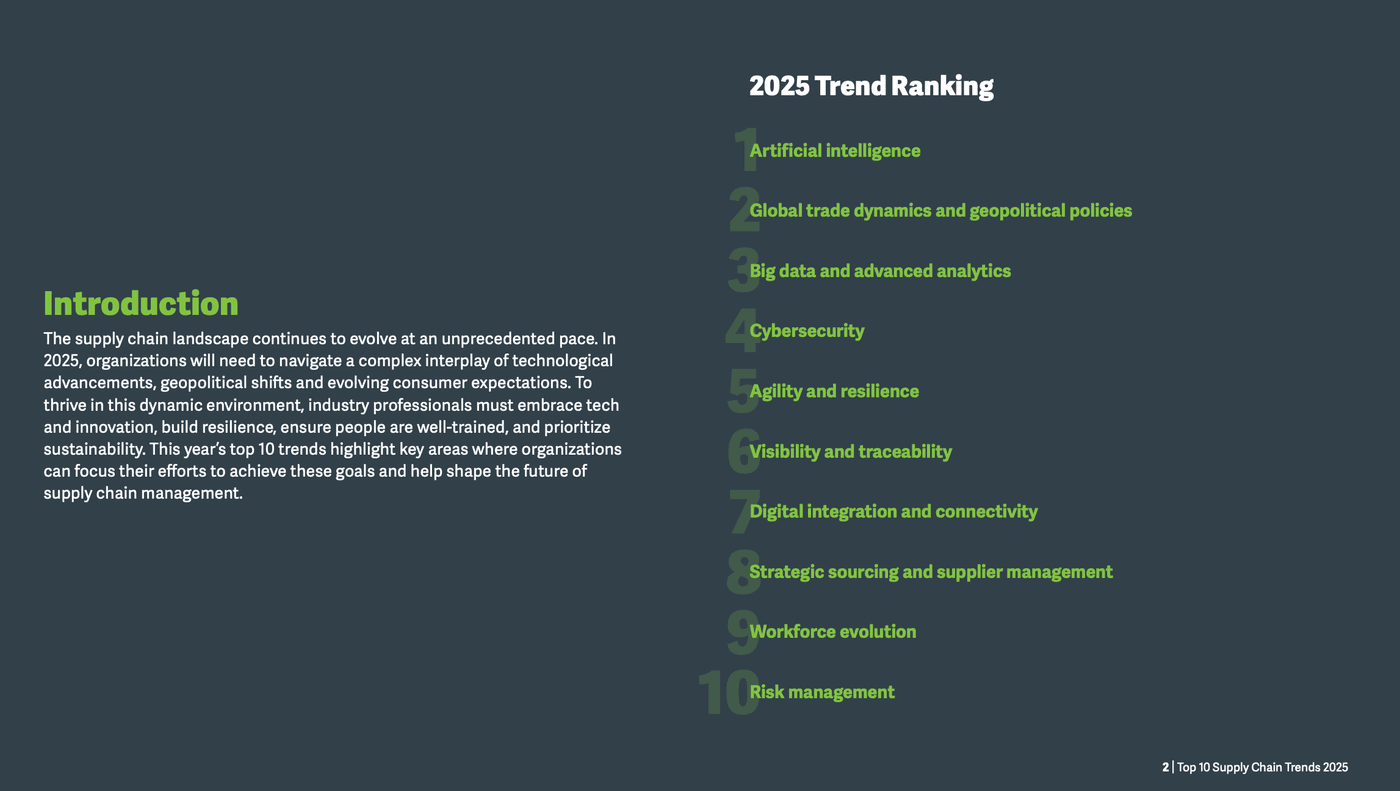News
Navigating the future: ASCM's insights into 2025 supply chain trends
04/01/2025
The world is evolving rapidly, and supply chains are no exception. Staying competitive requires understanding the latest trends driving the industry. ASCM's Top 10 Supply Chain Trends for 2025 outlines priorities shaping innovation and results.
A standout trend is artificial intelligence (AI), which powers transformative technologies across industries. AI is revolutionizing areas like food manufacturing, retail, medical forecasting, and beyond. It optimizes transport routes, predicts demand, ensures quality with computer vision, and enhances packaging and assembly processes.
Cybersecurity is equally critical as the growing reliance on data attracts increasingly sophisticated hackers. AI also plays a dual role here, used both to bolster defenses and by attackers to exploit vulnerabilities. This highlights how interconnected these trends are and underscores the speed at which supply chain operations are evolving.
Adapting to this pace requires a workforce evolution. Talent shortages and the increasing importance of tech skills make upskilling and reskilling essential. By equipping employees for a more automated and digital environment, organizations not only meet current demands but also strengthen their supply chain's resilience.
This year’s report dives deeper than ever with new sections exploring practical applications, industry-specific examples, and actionable preparation tips for each trend.
The future of supply chain promises exciting possibilities—start preparing today.

1. Artificial intelligence:
In an era of unprecedented AI advancements, intelligent sourcing, inventory management, and logistical route-planning are revolutionized. Cobots, computer vision, and machine learning reshape supply chain operations, promising immediate returns and long-term strategic advantages.
2. Global Trade dynamics and geopolitical issues
Geopolitical conflicts, economic shifts, and climate concerns drive the trend towards regionalization. The deglobalization of supply chains may enhance security but raises challenges like increased prices and reduced innovation.
3. Big data and advanced analytics:
Leveraging big data and analytics emerges as a cornerstone for efficiency. Organizations are well-positioned to identify inefficiencies, reduce costs, and enhance customer service through applications like standardized data exchange and predictive maintenance.
4. Cybersecurity:
As supply chains go global, so do cybersecurity threats. Cybercriminals know no boundaries, emphasizing the core role of cybersecurity in safeguarding digital and intelligent networks.
5. Agility and resilience:
In a consumer-centric world, supply chains must predict, prepare, and respond rapidly. Agility demands new capabilities, collaborative robots, and flexible workforces, fostering resilience embedded with digitization, optimization, sustainability, and talent development.
6. Visibility and traceability
Enhanced visibility and traceability form the bedrock for real-time data insights. Combined with AI and location intelligence, organizations gain unprecedented predictive capabilities based on historical data.
7. Digital integration and Connectivity
Organizations are set to convert data into digital formats, paving the way for interconnected, intelligent ecosystems. This transformation emphasizes the delicate balance between long-term automation investments and immediate solutions to reduce repetitive tasks.
8. Strategic Sourcing and supplier management
Strategic partnerships, integrated procurement, digitization, and collaboration boost supply chain efficiency. Greater integration with third parties enhances performance, while innovation-driven procurement optimizes product life cycles. Companies should diversify sourcing, build multiple supplier relationships, and prioritize long-term partnerships to simplify networks, improve efficiency, and reduce risk.
9. Workforce Evolution
Workforce evolution in supply chains is shaped by technology and shifting leadership styles. Industry 5.0 and enhanced human-machine interactions boost efficiency, but a skilled labor shortage persists due to demographics and automation. Investing in talent development is essential, as human labor remains vital for productivity amid rising competition for skilled workers.
10. Risk management:
Disruption is now the norm, from transportation congestion to global pandemics. The shift is towards constant preparation through effective risk management, including diversifying suppliers, building inventory, and continuous monitoring.
To receive the complete report Top 10 Supply Chain Trends 2025, please contact Jessica Mariotti at info@advanceschool.ch
Courses linked
-
Master APICS CSCP - Certified Supply Chain Professional - Interactive Live Webinar
The Executive Master CSCP Interactive live webinar is designed to prepare the candidate for the Certified Supply Chain Professional certification (CSCP) of APICS, in the Supply Chain Management area. » -
SCOR DS - Supply Chain Operations Reference Model - Interactive Live Webinar
The course demonstrates how to use the SCOR model to design a Supply Chain that improves performance and support business strategy. At the end of the training, candidates will receive an official Letter of Completion from ASCM/APICS. » -
Technology Certificate - APICS
Stand out in a competitive job market with the new ASCM Supply Chain Technology Certificate. This certificate gives you an understanding of how to implement the latest technologies in your Supply Chain organization to reduce costs, boost performance and achieve a more sustainable Supply Chain. Explore how blockchain and other emerging technologies can support and improve operations within the Supply Chain industry. » -
Planning Certificate - APICS
ASCM online state-of-the-art course designed to transfer knowledge and best practices to plan a Supply Chain and ensure synchronization of all functions to improve flow. At the end of the course, you will receive the ASCM Supply Chain Planning Certificate. »







